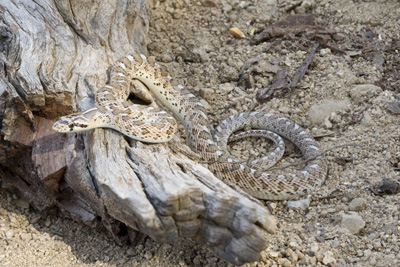

Although I've reported on the Helicon Focus Filter previously, on our Arizona High Speed Flash Photography Shoots I had an opportunity to once again play with the filter and create some exciting shots. As you may recall, in my previous discussion about the filter I mentioned how your subject must be motionless while you're shooting, otherwise the sharp edges may not match up. That certainly still holds true, but let me point out some points when doing composing and laying out the images.
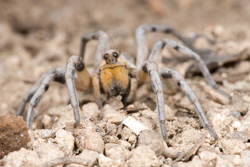
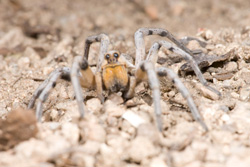
I shot a series of approximately 8 shots of this large desert
wolf spider, 'rolling' the focus from the pebbles in the foreground
to the last leg segment of the spider. If you look carefully,
the image actually seems to have shifted. You'll note a small
rectangular piece of wood next to the left front leg (the right
side in this spider) is a bit higher up in the frame, and there
are more foreground pebbles in the image on the right.
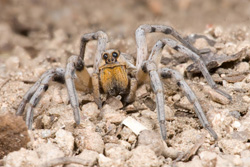
The finished image nonetheless corrected for this and the finished image was sharp throughout. There were a few artifacts that appeared in the out-of-focus area behind the spider, but simple cloning corrected for that. It's important to keep the camera rock steady as you roll the focus, otherwise the chance of misregistry is definitely increased. Lighting needs to be consistent, too, and if you're using flash -- as I was for shooting the spider, pace yourself so that the flash has time to recylce fully between each image. Otherwise, if one or more shots aren't fully exposed, you might have gaps in the focused area, and that won't work either.
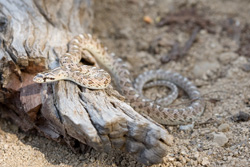
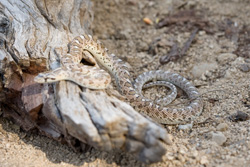
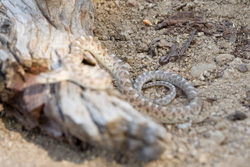
About eight shots were used for this glossy snake. The three included shows the head, mid-body and tail area, and the background. You can clearly see the differences in focus between the first and last image, with foreground sharp in one, soft in another, and the same for the background. Snakes pose another problem, and that is, if the snake is stressed or excited it might breathe deeply, and its body size will flucuate between shots. If that's the case, either wait until the snake calms down, or shoot fast, trying to time your shots between breaths of the snake.

DEC - A solution to the Digital Dilemma
Western Digital portable external Hard Drives
CS3 Upgrade
Framing with a Telephoto Against a Desert Sunrise
Adobe
Photoshop LIGHTROOM
Workflow
and Workload - You Can Keep Ahead
Bring
along a Point N Shoot
Backing Up Your
Digital Files - you'll need more than you think
Action
Wildlife Photography Camera Settings
HELICON FOCUS
Filter maximizing depth of field digitally
Capture 1's
Most Useful Features
DIGITAL
Photographing scenes with extreme exposure values
Effective
Cloning in Adobe CS2
Watch Your Backgrounds
- The potential of composites or shooting in RAW format
DIGITAL
-Shoot for the Future
DIGITAL-Shoot
for the Future, Part II
The
Helicon Focus Filter Revisited
Smell
the Roses
Frankly access your skills before deciding upon a workshop
The Songs of Insects - a super book on katydids, cicadas,
and grasshoppers
A
Great Insect Field Guide
Action
Wildlife Photography Camera Settings
The
Pond-A Must-See shooting Location in southern Arizona
Don't
take in baby wild animals
Seize the Moment!
Take
a Workshop First
Luck, what is it?
At the Pulse
of Life by Fritz Polking
Carry-on
Luggage for small commuter flights
Two
Sturdy, Light-weight tripod heads by AcraTech
Lens
Coat equipment covers
The Ultimate
Long Lens Case - McDonald Safari Bag
Positioning your Roll-on
Carry-On bag
New
Lens Covers for Long Lenses
The
Best All-Around Lens
Keep Your Head Up
Save Your Equipment from
Crashing!
The L-Bracket,
the ultimate camera bumper
Visual
Echos Tele-Flash for the 580EX Flash
Testing
your Flash's Aim
The Ultimate
Flash Bracket
Using
TTL flash with Hummingbirds
Specular
highlights and the flashing frog
Geared Focusing Rail
for Macro Work
Shooting
in Inclement Weather
Low
level tripod work
Sighting in a very, very
long lens
Padding
Your WimberleyTripod Head
Using The Wimberley
Gimbal head with a camera body
Wimberley
400 and 600mm IS plate
How
do we protect our gear from dust, and carry our gear when on safari
How do
you shoot the Moon?
If
you see it, it's too late -- a lesson in anticipation
Protecting
your long lens from SAND, the pleasures of beach photography
Maximum
Depth of Field and Hyperfocal Distance - they're not the same
thing!
A
great depth of field guide
Carry Your Gear!
Custom Function 4-1
for Nikon and Canon shooters
Sigma's 120-300 f2.8
APO zoom telephoto lens
A Car
Tip that could Save Your Life
A Great Website for Information
- the Singapore Nature Photography Society
Airline
Carry-On Luggage -Let your concerns be heard!
Ask Questions Before You
Go
Liquids
in your Levels - TSA Warnings!
Disconnect
-- travel precautions
Photograph America
Newsletter
Obey
the Rules
Wildlife
Portraiture
Drying out boots
with newspaper
Removing
Cactus Spines
The
Ti Chi Stalk
Photographing
Critically Endangered Sites
The Sibley
Bird Guides
Contact us by e-mail: info@hoothollow.com
Or FAX us at: (717) 543-6423.